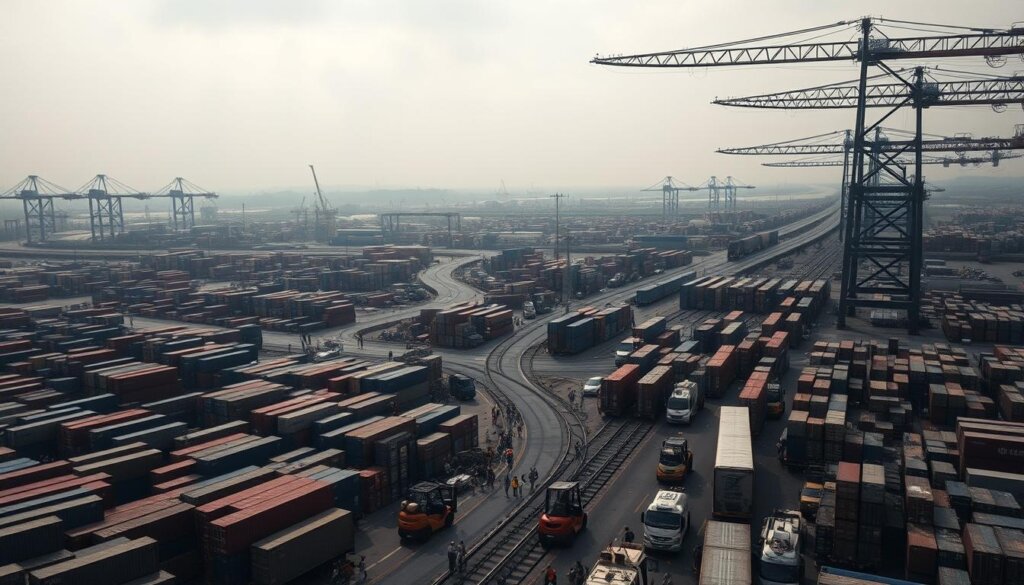I remember opening a van at 6 a.m. and deciding which parts to carry for a long service day. I had one slot for a high-value part and another for a common fastener. That small choice shaped whether I fixed devices on the first visit or booked a return call.
Recent shocks like COVID, geopolitical strain, and climate events taught me that lean setups can break quickly. I now blend approaches: a tighter flow for routine parts and selective buffers for critical items.
My work is practical. I balance cash tied up in stock, obsolescence risk in slow movers, and the real costs of missed appointments and repeat truck rolls. I watch supply chains and lead variability closely so my crews stay productive across wide territories.
In this piece I’ll map a clear framework to pick the right strategies by part criticality, demand patterns, and service impact. Expect actionable guidance that translates manufacturing ideas like jit into field service realities—truck stock, regional staging, and technician workflows.

Key Takeaways
- Blend approaches: use flow for low-risk parts and buffers for critical ones.
- Measure costs in cash, reschedules, and repeat visits.
- Monitor supply chain signals and lead-time variability.
- Classify parts by criticality, demand, and obsolescence risk.
- Build flexible operations that protect uptime without overspending.
Why this comparison matters now for field service operations
Longer supplier delays have forced me to rethink how I stage parts near my technicians. Extended lead times, raw material shortages, and transportation hiccups are creating frequent stockouts that hit service delivery first.

Present-day supply chain disruptions, lead times, and customer SLAs
Today the supply chain is more volatile. That volatility pushes up lead times and makes fast turnarounds harder to promise.
Missed shipments and transportation delays translate into missed appointments and SLA penalties. Those penalties often exceed the savings from cutting inventory too far.
My goal: balancing cost, risk, and responsiveness in the United States market
In the U.S., customer demand for same-day or next-day fixes is common. My aim is to balance cash tied up in stock with service reliability and technician productivity.
I reassess strategies when supplier variability shows up, choosing where lean flows work and where a small buffer is essential to prevent costly repeat visits.
Inventory Buffering vs Just-In-Time: what each strategy really means
The way I stage parts drives first-time fixes and shapes my daily costs. Below I lay out the practical meaning of two common approaches so you can pick what fits your field operations.
Safety stock and absorbing variability
I define this approach as keeping safety stock for critical SKUs so technicians complete repairs on the first visit even when suppliers slip. Safety units absorb demand variability and lead swings so ops can continue during disruptions.
Pull-driven replenishment and lean flow
JIT in my world means fewer parts on hand and tighter coordination with suppliers. It aligns replenishment to actual use, minimizing inventory levels and waste and improving cash position.
That pull-system mindset relies on precise scheduling and reliable suppliers; defects or late orders expose the field to missed calls.
Field service realities
Field networks are decentralized: vans, lockers, and micro-depots spread parts across geography. I set truck min/max levels and use simple kanban cues to make replenishment visible for techs who are always on the move.
First-time fix is my north star. For high-impact or volatile goods, I prefer safety stock. For low-risk items, I lean on JIT and supplier coordination to drive efficiency.
Cost tradeoffs in field service: holding cost vs stockout risk vs speed
When lead times stretch, the math between holding costs and missed calls gets stark fast. I balance cash tied up in parts against the chance of a costly service delay.

Inventory holding costs across vans and depots
I break down inventory holding costs as cash locked in slow movers, obsolescence when models change, and limited shelf space in vans or micro-depots.
Those factors add handling time and hidden real estate expense across my field operations.
Stockouts, service delays, and SLA penalties
Stockouts trigger emergency expedites, reschedules, and second truck rolls. Those actions often cost more than the savings from minimizing inventory levels.
Prolonged lead times and transportation delays make those risks worse, so I assign safety stock to high-impact goods.
Demand patterns and variability
Seasonal spikes, heat-related failures, or firmware swaps change demand in ways historical averages miss.
Safety stock buffers protect service continuity when the supply chain shows volatility.
Waste reduction and efficiency
Where supplier quality and cadence are reliable, JIT cuts waste and boosts efficiency by minimizing waste and improving turns.
But in disrupted chains a lean approach can strand technicians, so I mix strategies: buffers for long-lead components like compressors or control boards, and flow for consumables and fasteners.
Building a hybrid approach that fits your supply chain and demand patterns
I begin by mapping failure impact and lead volatility, then assign where to hold local spares and where to pull on demand. That risk-first view keeps my vans and micro-depots focused on goods that would otherwise force repeat visits or SLA misses.
Segmenting parts to set inventory levels and safety stock
I segment my catalog by service criticality, failure rate, and lead variability. For high-consequence parts I set higher safety stock and local staging. For stable, low-impact SKUs I run a tighter cadence tied to actual usage.
Supplier collaboration, forecasting, and enabling systems
I lock cadence with suppliers and improve forecasting with analytics that factor installed base age and seasonality. That reduces risk and smooths replenishment cycles.
I use ERP and WMS to manage order flows, and deploy ASRS at regional DCs where density matters. These systems boost accuracy and speed fulfillment so JIT and small local buffers coexist.
Actions I track: first-time fix, backorders, van-space utilization, and service-level compliance. I standardize simple kanban or min/max cues so techs trigger replenishment without extra admin. Finally, I share the tradeoffs with finance and field leaders so the hybrid approach balances waste reduction and service resilience.
Conclusion
I’ve found the strongest teams blend lean flows with targeted spare holdings to keep service steady. That mix uses lean methods for stable goods and local spares for parts that would force repeat visits.
Practical tools make it work: clean data, dependable systems like ERP and ASRS, and close supplier coordination to keep replenishment visible and predictable across the supply chain.
Cost logic matters. I cut waste and lower levels where demand is steady, and I spend deliberately on buffers where downtime or escalations would cost more. This approach supports steady operations and high first-visit resolution.
Your next step is simple: segment parts by service impact, set rules that match routes and depots, and tune replenishment so your company balances resilience and production efficiency.
See how FieldAx can transform your Field Operations.
Try it today! Book Demo
You are one click away from your customized FieldAx Demo!
FAQ
What are the main differences between keeping on-hand parts and running a lean replenishment system for field service?
I see the core difference as risk versus cost. Holding stock in vans and depots reduces the chance of missed appointments and improves first-time fix rates, but it raises carrying costs, obsolescence risk, and requires more capital and space. Running a lean replenishment model cuts holding costs and waste by relying on faster supplier coordination and frequent deliveries, yet it increases exposure to lead-time variability and supply disruptions that can trigger SLA penalties and emergency shipping fees.
Why should field service teams care about this comparison right now?
Supply chains are still facing longer lead times and intermittent disruptions, and customers expect faster service. I care because these pressures make tradeoffs sharper: the cost of a stockout is higher, and the cost of holding excess parts has risen with transportation and capital costs. Balancing responsiveness and cost is essential to protect revenue and customer satisfaction in the current U.S. market.
How do lead times and demand variability affect my parts strategy?
Longer lead times and unpredictable demand push me toward keeping more safety quantities to avoid costly delays. When lead times are short and reliable, I feel comfortable tightening stock and using more frequent replenishment. The more volatile the parts usage, the more buffer I’ll maintain for critical items to prevent service interruptions.
Which parts should I keep in vans versus at central depots?
I recommend segmenting parts by criticality and usage patterns. Keep high-turn, service-critical items and commonly required consumables on vans for quick fixes. Store bulky, low-turn, or slow-moving parts at depots or centralized locations where automated storage or batch replenishment makes sense. That mix reduces van weight and carrying cost while preserving first-time fix performance.
How does a hybrid approach work in practice?
In practice, I combine on-vehicle stock for mission-critical and high-frequency parts with just-in-time replenishment for predictable, lower-priority items. I collaborate with suppliers for faster lead times on critical SKUs and use forecasting tools in my ERP to trigger replenishment. The hybrid model lets me lower overall carrying cost without giving up responsiveness where it matters most.
What systems help me balance lean replenishment and buffers?
I rely on ERP modules, demand forecasting, and automated storage solutions like ASRS to set reorder points and allocate stock. Telematics and mobile inventory apps help me monitor van levels in real time, which supports dynamic replenishment and prevents stockouts. Supplier portals and EDI connections speed up restocking and reduce manual lead-time uncertainty.
How do I measure whether my strategy is working?
I track first-time fix rate, on-time SLA compliance, carrying cost per technician, emergency freight spend, and stockout incidents by SKU. Improvements in those KPIs indicate I’m balancing cost and service well. I also monitor inventory turns and obsolescence write-offs to ensure I’m not overstocking low-use parts.
What risks should I expect if I move aggressively toward lean replenishment?
I accept higher sensitivity to supplier delays, transportation disruptions, and sudden demand spikes. That can mean more emergency shipments, longer customer waits, and potential SLA penalties. To mitigate that, I build supplier relationships, keep strategic safety quantities for critical SKUs, and create contingency plans for key routes and carriers.
Can supplier collaboration replace on-hand buffers entirely?
Rarely in field service. Strong supplier collaboration and reliable carriers reduce the need for large buffers, but they don’t eliminate risk—especially for emergency or seasonal demand. I usually keep minimal safety quantities for critical components while negotiating faster replenishment for others, rather than removing on-hand stock completely.
How do transportation delays and regional differences affect my strategy across the U.S.?
Regional lead times and carrier reliability vary, so I adapt my approach by geography. In fast, reliable corridors I tighten stock; in remote or weather-prone regions I hold more on-hand parts. I also adjust safety quantities around known seasonal peaks and route-specific delays to keep service levels consistent nationwide.
Author Bio
Co-Founder & CMO at Merfantz Technologies Pvt Ltd | Marketing Manager for FieldAx Field Service Software | Salesforce All-Star Ranger and Community Contributor | Salesforce Content Creation for Knowledge Sharing






